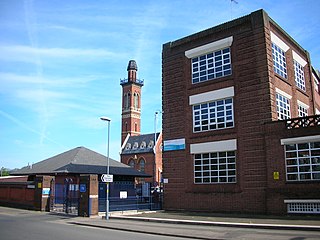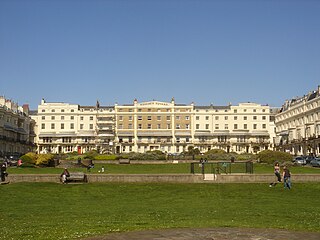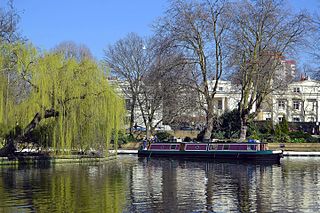
Regency House is a grade II* listed house at 7 Church Street in Framlingham, Suffolk, England. The house is timber-framed, of three storeys, and dates from the early nineteenth century. It is in use as a shop and house. [1]

Regency House is a grade II* listed house at 7 Church Street in Framlingham, Suffolk, England. The house is timber-framed, of three storeys, and dates from the early nineteenth century. It is in use as a shop and house. [1]

The Regency era of British history officially spanned the years 1811 to 1820, though the term is commonly applied to the longer period between c. 1795 and 1837. King George III succumbed to mental illness in late 1810 and, by the Regency Act 1811, his eldest son George, Prince of Wales, was appointed prince regent to discharge royal functions. When George III died in 1820, the Prince Regent succeeded him as George IV. In terms of periodisation, the longer timespan is roughly the final third of the Georgian era (1714–1837), encompassing the last 25 years or so of George III's reign, including the official Regency, and the complete reigns of both George IV and his brother William IV. It ends with the accession of Queen Victoria in June 1837 and is followed by the Victorian era (1837–1901).

Ickworth House is a country house at Ickworth, near Bury St Edmunds, Suffolk, England. It is a neoclassical building set in parkland. The house was the residence of the Marquess of Bristol before being sold to the National Trust in 1998.

Coade stone or Lithodipyra or Lithodipra was stoneware that was often described as an artificial stone in the late 18th and early 19th centuries. It was used for moulding neoclassical statues, architectural decorations and garden ornaments of the highest quality that remain virtually weatherproof today.

Edgbaston Waterworks lies to the east of Edgbaston Reservoir, two miles west of the centre of Birmingham, England.

Abbas Hall is a small country house in Great Cornard, a village located near the town of Sudbury, Suffolk in England, the Elizabethan exterior of which masks a medieval two-bay aisled hall of c.1290, from which two massive oak posts with moulded capitals and two arches of the screens passage survive. The inserted floor in the great hall was put in about 1548–49. The house was originally the house of West Malling Abbey's manorial steward here. The house, from the grounds of which Thomas Gainsborough painted his celebrated view of Great Cornard Wood, was restored by the present owner, Stefan Kosciuszko, Chief of Staff Hinduja Group, and chief executive AMAS-IPS, the project development company for the Group, after 1995.

Brunswick Town is an area in Hove, in the city of Brighton and Hove, England. It is best known for the Regency architecture of the Brunswick estate.

For the church building designed by Frank Lloyd Wright see Unitarian Meeting House

Monkspath is a large residential community and light-industrial area of Solihull, West Midlands, England, southeast of the town's Shirley district. Monkspath is in the Blythe ward of the Metropolitan Borough of Solihull.

Aceh Tamiang Regency is a regency in the east of Aceh province of Indonesia, bordering on North Sumatra Province to the east. It is located on the island of Sumatra. The regency covers an area of 1,957.02 square kilometres and had a population of 251,914 people at the 2010 census and 294,356 at the 2020 Census; the official estimate as at mid 2021 was 297,522. The seat of the regency government is at the town of Karang Baru.
This is an article about the extreme points of Indonesia.

The Landtag of Prussia was the representative assembly of the Kingdom of Prussia implemented in 1849, a bicameral legislature consisting of the upper House of Lords (Herrenhaus) and the lower House of Representatives (Abgeordnetenhaus). After World War I and the German Revolution of 1918–19 the Landtag diet continued as the parliament of the Free State of Prussia between 1921 and 1934, when it was abolished by the Nazi regime.

Regency Square is a large early 19th-century residential development on the seafront in Brighton, part of the British city of Brighton and Hove. Conceived by speculative developer Joshua Hanson as Brighton underwent its rapid transformation into a fashionable resort, the three-sided "set piece" of 69 houses and associated structures was built between 1818 and 1832. Most of the houses overlooking the central garden were complete by 1824. The site was previously known, briefly and unofficially, as Belle Vue Field.

Roundhill Crescent is a late-19th-century housing development in Round Hill, an inner suburb of the English coastal city of Brighton and Hove. Partly developed in the 1860s with large terraced houses on a steeply sloping open hillside, the crescent—which "curves and changes height dramatically along its length"—was finished two decades later and now forms the centrepiece of the Round Hill conservation area. Smaller houses completed the composition in the 1880s, and England's first hospital for the treatment of mental illness was founded in the crescent in 1905. The five original sets of houses from the 1860s have been listed at Grade II by English Heritage for their architectural and historical importance, and the crescent occupies a prominent place on Brighton's skyline.

Vernon Terrace is a mid 19th-century residential development in the Montpelier suburb of Brighton, part of the English coastal city of Brighton and Hove. Construction of the first section started in 1856, and the 37-house terrace was complete in the early 1860s. Architecturally, the houses divide into five separate compositions, although all are in a similar late Regency/Italianate style. This was characteristic of houses of that era in Brighton, and especially in the Montpelier area—where the Regency style persisted much later than elsewhere. Standing opposite is the landmark Montpelier Crescent, which had a view of the South Downs until Vernon Terrace blocked it. Three groups of houses in the terrace have been listed at Grade II by English Heritage for their architectural and historical importance.

Riddlesworth Hall School is a former country house. It now serves as a boarding school. It is located in Riddlesworth, Norfolk, England.

Gothic House is a Gothic-style building in the centre of Brighton, part of the English city of Brighton and Hove. Although it has been in commercial use for more than a century, it retains some of its original appearance as "one of the most fascinating houses" built by the prolific partnership of Amon Henry Wilds and Charles Busby. It is the only Gothic Revival building they are known to have designed: they typically adopted the Regency style, sometimes with Classical or Italianate touches. The building is Grade II listed.

Little Venice is a district in West London, England, around the junction of the Paddington Arm of the Grand Union Canal, the Regent's Canal, and the entrance to Paddington Basin. The junction forms a triangular shape basin. Many of the buildings in the vicinity are Regency white painted stucco terraced town houses and taller blocks (mansions) in the same style. The area is 2.5 miles (4.0 km) west-north-west of Charing Cross and immediately north-west of Paddington.

The Queen's Head is a pub at 144 Stockwell Road, Stockwell, London SW9.

Adelaide Cottage is a house in Windsor Home Park just east of Windsor Castle, in Berkshire. It is the principal residence of the Prince and Princess of Wales.

As of February 2001, there were 1,124 listed buildings with Grade II status in the English city of Brighton and Hove. The total at 2009 was similar. The city, on the English Channel coast approximately 52 miles (84 km) south of London, was formed as a unitary authority in 1997 by the merger of the neighbouring towns of Brighton and Hove. Queen Elizabeth II granted city status in 2000.
Coordinates: 52°13′20″N1°20′43″E / 52.22211°N 1.34514°E